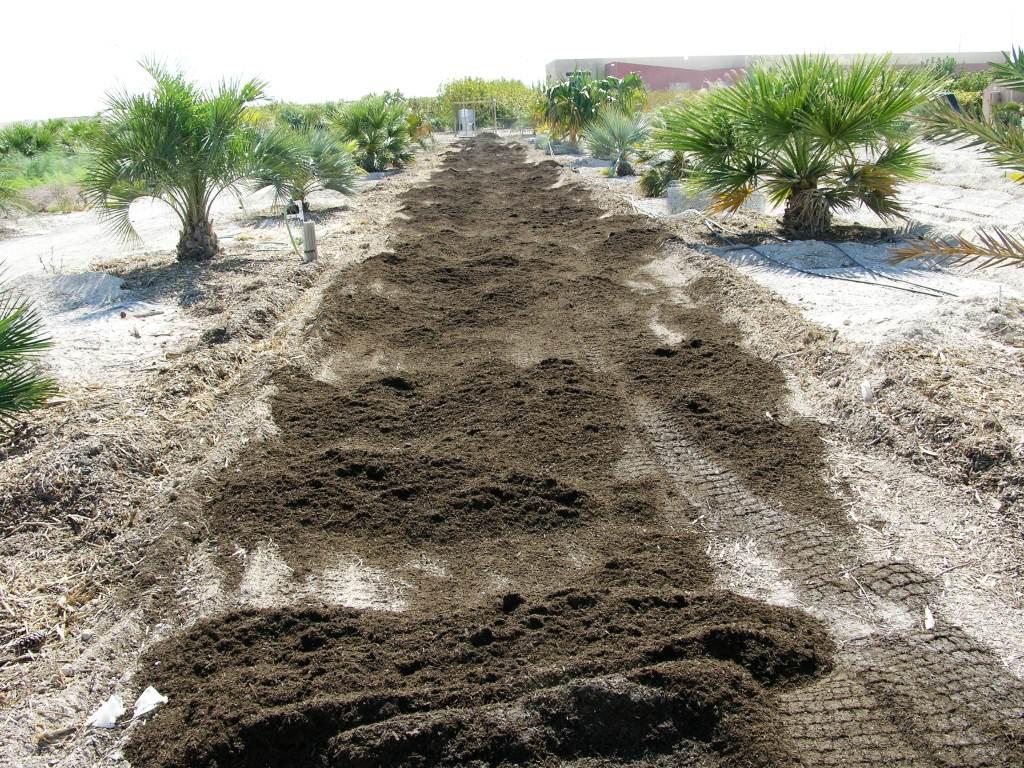Q. I’m planting new fruit trees and landscape trees this year. I noticed there is a consensus out there that fruit trees, trees and shrubs should be backfilled with native soil without using any amendments. However, is there an exception in Las Vegas with the soil is exceptionally poor? Typical “native” or “natural” desert soil in Las Vegas. Would you plant directly in this? I hope not. Here is the SAME soil (25 feet away) ten years later after wood chips were spread on the soil surface and water was applied for fruit trees. Now which soil would plants be “happier” growing in? A. You are right and my advice is bucking conventional advice from most places. For instance, using native soil for backfill in North Carolina will be fine in most cases. But it also depends on what is planted. Many urban landscapes have “fill” that was brought in by the developer or general contractor. Most fill…No, I take that back…ALL fill… used in urban desert settings is junk. Using soil amendments depends on the soil and also the plants. Let me explain why. Desert Soils Vary in Organic Content Some desert soils are okay to plant into directly and you will have few problems. Others are not. Much of it depends on the organic matter content of the soil and the type of plants. If your soil contains at least 5% organic matter at the time of planting, the addition of organics to the soil as a soil amendment probably won’t do much. If the plants going into the soil prefer growing in highly organic soils, you are probably going to see a problem if the organic content is only 5%.For instance, a soil with low organic content but suitable for lawn grasses or some trees and shrubs will not be suitable for annual flowers or vegetables. Soils are a Mixture of Sand, Silt, Clay AND Organics Soils are a mixture of minerals and organic content that results from dead plants and animals that decompose into the soil. Desert soils with very low rainfall like ours. This is a jar test. I have students do this to their soils at home. First of all, the soil is darker in color which means it has organics in it unless it is a soil like a Latersol in the tropics. This is NOT a desert soil. I can tell from the color. The organic component has mixed in with the soil particles and colored it darker but the larger stuff either floats on the surface or is the very top layer on top of the clay layer. When planting without soil amendments such as compost, soil organic matter content should be at least 5% if you don’t want the plants to be “unhealthy”. If it is lower than this, add organic content to the soil such as a good quality compost. Mix it with the soil taken from the planting hole. Another option is to use a soil mix for filling the planting hole around the tree roots or container roots. Soil mixes are like Hamburger Helper; they contain organics and it is convenient and easier to use than mixing the soil yourself. Soil color can tell you alot about a soil. This cark soil color tells me there is a good amount of organics in it and will not need to be amended for lawns and some trees and shrubs. Be careful of adding too much organic content to the soil. This can work against the establishment of the plant in the surrounding soil. This is the situation with research done in Oklahoma, Arizona and other states. These practices of “not adding organic matter” to the soil at planting is from their research with soils already high enough in organic matter to make little difference after platning. This is the same desert soil you saw above. Organics are added to this desert soil AND the soil is covered in wood chips to add organics to the soil over time as long as there is rain or irrigation. Many soils of the Mojave Desert with very low rainfall are extremely low in organics. Soils in the desert that are relatively high in rainfall or were previously farm land (under irrigation). These are usually already high enough in organics and adding more does little, if any, good. Using the deserts of the Southwest as an example (Sonoran, Mojave, Chihuhuan, Great Basin) they range in historical rainfall from 4 inches to over 10 inches of rainfall each year. This is a 250% difference depending on locale!!! Of course we will see different types of plants and a difference in plant density and canopy size when we compare desert environments with a difference in rainfall of 250%!!! This is reflected in soil differences there as well. We see differences in organic content, salts, pH, etc. Map of the US showing organic content of soils and how it varies with rainfall. Desert soils are always lower in soil organics than soils in wetter climates unless they are amended. How Do You Know the Organic Content of a Soil? We can send it to a soil testing laboratory and spend maybe $75 to $100 and wait for three weeks for a reply or use our noggin and get a rough approximation. The soil testing lab will give you a precise amount in the sample sent to them. If the sample sent to them is representative of the soil that interests us, then it may be fairly accurate. But, garbage in, garbage out. If the sample is NOT a good representation of the soil that interests us then it is garbage. Look at the soil Soil color is a pretty good indicator of soil organic content. Rich soils, full of organics are brown to black. The lighter the color, the less organics in it. If the soil is moist and dark brown, you probably don’t have to add anything. If
